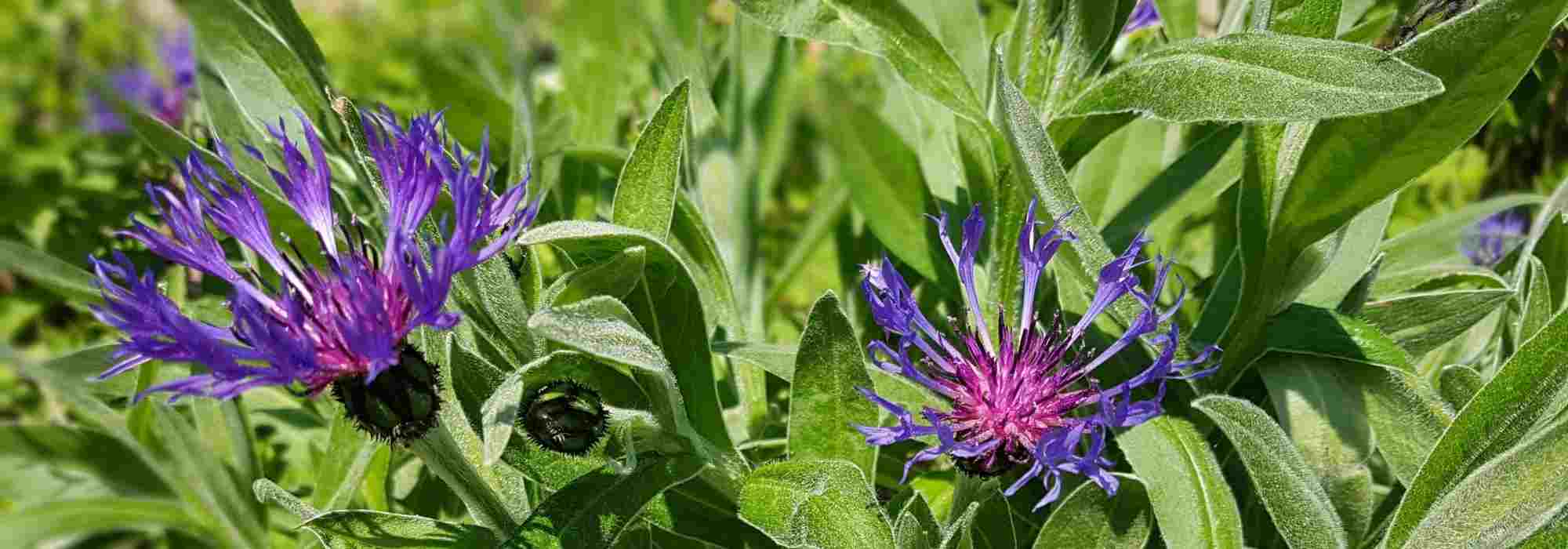
Centaureas, cornflowers: how to choose them well?
All the criteria for selecting the best varieties!
Contents
The Centaureas, commonly known as Mountain Cornflowers, are robust perennials that are highly adaptable and easy to grow. From groundcovers to more upright species, there is a varied palette, further enriched when considering the shape of the inflorescences or their different colours. Mostly deciduous, some do offer evergreen foliage, which can be quite decorative. Capable of flowering from spring until the first frosts, there is something for nearly every season. To help you decide which ones to select for your garden, we present a brief overview of their various characteristics.
According to the flowering period
Centaureas can brighten up the garden for a long period, and by choosing certain species and varieties, it is possible to see them in flower from spring to autumn. Furthermore, if you regularly remove faded flowers, they can provide multiple bloomings.
Early Flowering Centaureas
The Elegant Centaurea forms a dense, low groundcover that, from April in the mildest regions, is covered with corollas resembling small pink pom-poms with a white centre, supported by sturdy stems. Also very early, the Centaurea montana ‘Amethyst Dream’ displays its delicately toned purple flowers from mid-spring. From the same species, the Mountain Centaurea ‘Purple Heart’ showcases strongly contrasted bicoloured flowers, mixing pure white with a purple heart for a striking graphic effect.
 Centaurea montana ‘Amethyst Dream’For Late Spring and Early Summer
Centaurea montana ‘Amethyst Dream’For Late Spring and Early Summer
While early varieties may bloom again in mild, humid weather, some other species reveal their charms a bit later, thus taking over or even accompanying the earlier ones. This is the case with the Mountain Cornflower, a wild species with natural charm, whose deep blue flowers with a violet centre brighten gardens from June to August. The Persian Centaurea displays carmine pink tones, which mark the end of spring, just like Centaurea ‘John Coutts’, whose fresh pink flowers are also slightly fragrant.
Other species are interesting during this period, such as the Oriental Centaurea or Centaurea ruthenica, both with flowers in various shades of cream white or yellow.
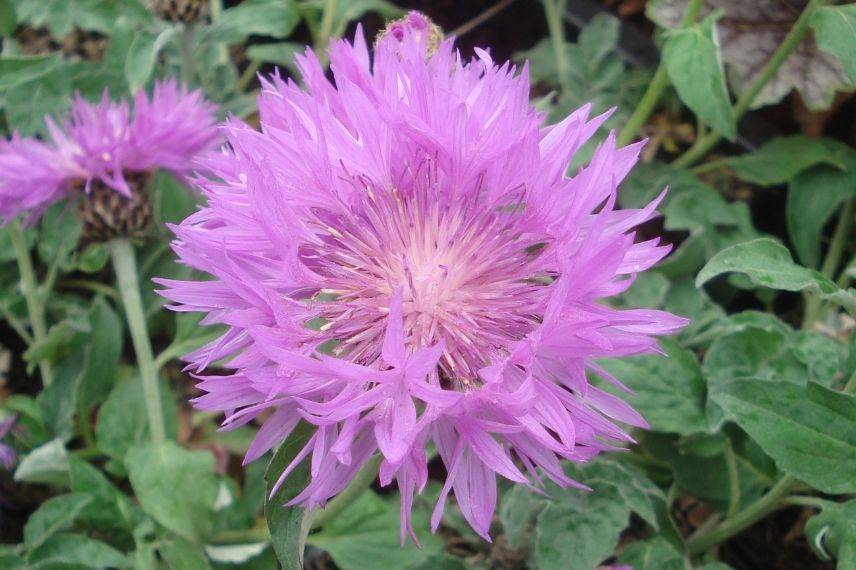 Centaurea hypoleuca ‘John Coutts’To Bring Colour in the Late Season
Centaurea hypoleuca ‘John Coutts’To Bring Colour in the Late Season
Sufficiently humid weather and a few regular actions encourage most Centaureas to bloom again. The Centaurea jacea can thus bloom generously in natural, countryside-style beds between September and October with its pink flower heads. A cousin of the cornflower, the Galician Serratula does not exceed 30 to 40 cm, but its mauve flowers are the latest, accompanying the last blooms and autumn foliage from late summer to the first frosts.
 Serratula seoanei (photo Wikipedia)
Serratula seoanei (photo Wikipedia)
Read also
Centaury: sowing, planting and careAccording to the colour of the flowers
Centaureas provide an interesting palette of different shades, from the softest to the more vibrant. It’s up to you to choose the colours that enhance a particular display, either by playing with gradients and tonal variations or by opting for contrasts instead.
Centaureas with mauve, blue, and pink flowers
If softer tones appeal to you, Centaurea bella, C. dealbata, C. jactea, C. ‘John Coutts’, and C. carnea offer rather pastel colours. For deeper shades, C. ‘Violetta’, C. montana as well as the varieties ‘Caramia’ and ‘Amethyst Dream’, or even C. ‘Stenbergii’ might be a better option.
 Centaurea montana ‘Carnea’ and Centaurea dealbata ‘Steenbergii’
Centaurea montana ‘Carnea’ and Centaurea dealbata ‘Steenbergii’
Centaureas with purple flowers
Some varieties are adorned with corollas that lean towards red or purple, such as Centaurea ‘Jordy’ or C. ‘Atropurpurea’, not to mention the darkest of them all, Centaurea ‘Black Sprite’, with almost black corollas.
 Centaurea montana ‘Jordy’ and Centaurea ‘Black Sprite’
Centaurea montana ‘Jordy’ and Centaurea ‘Black Sprite’
Centaureas with cream and yellow flowers
Sometimes less known than their neighbours, some Centaureas nonetheless show originality, offering heads of bright yellow flowers: C. macrocephala and C. orientalis are among them. Leaning more towards a cream tinged with sulphur yellow, the Mountain Cornflower ‘Sulphurea’ is a lovely variation.
 Centaurea orientalis and Centaurea macrocephala (photos Wikipedia)
Centaurea orientalis and Centaurea macrocephala (photos Wikipedia)
Centaureas with bicoloured flowers
For a bold dynamism, select varieties whose corollas mix several shades. C. ‘Amethyst in Snow’ and C. ‘Purple Heart’ are adorned with white and mauve flowers that give them a certain modernity. C. ‘Coerulea’ surrounds its violet heart with deep blue petals.
 Centaurea montana ‘Coerulea’ (Source photofarmer)
Centaurea montana ‘Coerulea’ (Source photofarmer)
Centaureas with white flowers
White is less common in this family, but Centaurea ‘Alba’ brightens any display with its immaculate white corollas.
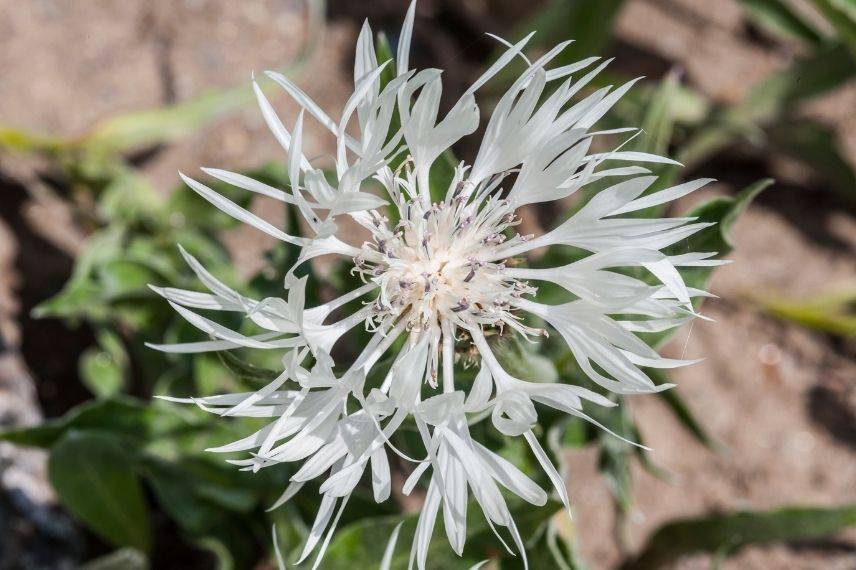 Centaurea montana ‘Alba’
Centaurea montana ‘Alba’
Discover other Centaurea
View all →Available in 2 sizes
Available in 2 sizes
Available in 0 sizes
Available in 2 sizes
Available in 1 sizes
Available in 1 sizes
Available in 1 sizes
Available in 1 sizes
Available in 1 sizes
Available in 2 sizes
According to the foliage
Centaureas are valued for their beautiful and generous flowering, but some also offer decorative foliage that can be utilised in landscaping.
Foliage in Grey Tones
While green is predominant, it can also be tinged with grey, a neutral colour that helps to link brighter shades together or highlight a particular colour. For instance, the foliage of Centaurea bella and C. orientalis displays greyish hues, just like that of C. atropurpurea, which is deeply cut and silvered. However, it is Centaurea pulcherrima that is the reference in this regard. This perennial forms a clump of about sixty centimetres in height during the season, with distinctly cut leaves that appear frosted with silver, thus becoming a focal point in a border.
Deciduous or Evergreen Foliage
Few Centaureas retain their foliage in winter. The plant “disappears” and enters dormancy until the following season. Sometimes, gardeners may prefer to see the space occupied year-round to maintain structure in all seasons. In this case, two species should be prioritised. Centaurea hypoleuca ‘John Coutts’ develops its pink, slightly fragrant flowers above a grey-green and villous foliage, which is semi-evergreen to evergreen. Forming a groundcover that is wider than it is tall, the elegant Centaurea forms a persistent cushion, also grey-green and fluffy, adorned with lilac flowers.
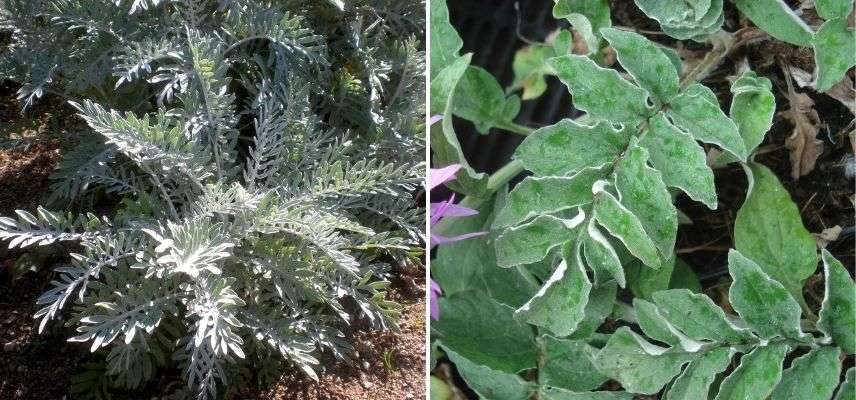
Foliages of Centaurea pulcherrima (photo Wikipedia) and to the right Centaurea hypoleuca ‘John Coutts’
According to the type of inflorescences
Centaureas bloom at the top of stiff stems, and the design of their flowers is reminiscent of that of thistles. Some varieties are true works of art, with fine and perfectly chiselled lines, such as those of the Mountain Cornflower and its various varieties.
In other species, the flowers resemble small, dense, hirsute pom-poms, as seen in the Yellow Centaurea, the Oriental Centaurea, and Centaurea ruthenica, with their globular cream-white flowers. Perhaps the most original is the Red Centaurea, whose flower heads mimic small purple thistles, emerging from a large ovate calyx that also contributes to the ornamental aspect of the plant.
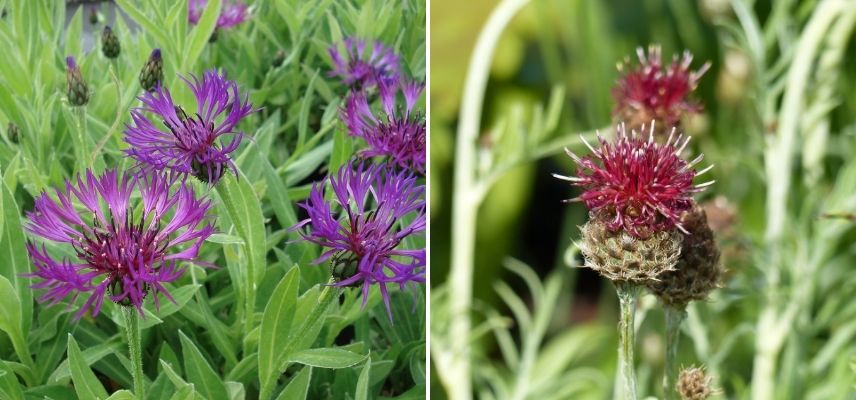
Inflorescences of Centaurea montana ‘Violetta’ and Centaurea atropurpurea
According to their dimensions
Although Centauries are generally small perennials (which allows them to be integrated into all gardens), their dimensions and habits can vary slightly. These differences influence their use in the garden, as well as the space they occupy in a flowerbed.
The most compact varieties
Ideal for use as groundcover, at the front of flowerbeds, or in rockeries or on slopes, these varieties gradually spread thanks to their rootstocks or stems that root upon contact with the soil. One of the most compact is undoubtedly Centaurea bella, which forms a dense tuft of evergreen foliage. Standing about twenty centimetres tall and 30 wide, it resembles a lovely cushion of lilac flowers. A little larger (40 cm in all directions), C. ‘Blacksprite’ and C. montana ‘Amethyst in Snow’ are also small-sized candidates. Deciduous, they bloom respectively in almost black and purple tones. Close to the Cornflower, Serratula seoanei remains similar in size, producing numerous mauve flowers.
The tall and upright varieties
The tallest Centauries add verticality to flowerbeds or in flowering meadows. Their stature allows them to be placed in the mid-ground or even the background, supporting shorter perennials. Centaurea dealbata, standing at 70 to 90 cm, is taller than classic Cornflowers (Centaurea montana). It forms a tuft with a beautiful presence and blooms in summer, in carmine pink tones. Even taller, Centaurea macrocephala is a giant. Everything about it is XXL! It can indeed rise to over 1.2m and forms an imposing and upright plant, creating beautiful verticality in a flowerbed or amidst a flowering meadow. Its dark green leaves are also large, and the plant is topped in summer with bright yellow inflorescences measuring 9 cm in diameter, which has earned it its botanical name.
The intermediate varieties
Between the compact varieties and the tallest ones, there is a whole range of Centauries of intermediate sizes, generally between 40 and 60 cm. This is certainly the case for most of the Mountain Cornflowers (which come in various varieties), but also for other species: C. jacea, C. orientalis, C. hypoleuca, C. carnea, C. atropurpurea, and C. ruthenica are similar in dimensions, differing by just a few centimetres.
- Learn all about sowing, growing, and maintaining Centauries in our plant sheet.
- Our various species and varieties of Cornflowers are available in our online nursery.

Centaury at the edge of a flowerbed
- Subscribe!
- Contents
![[plant_selector title="Choose your Cornflowers" subtitle="Discover our selection of {glossary} for your garden" button_text="See the selection"]](https://www.promessedefleurs.ie/blogwp/wp-content/uploads/2021/11/Centaurees-Choisir.jpg)

































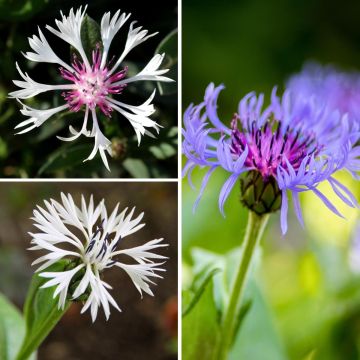
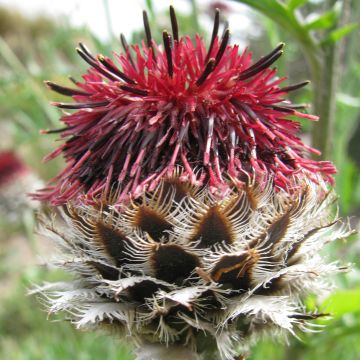
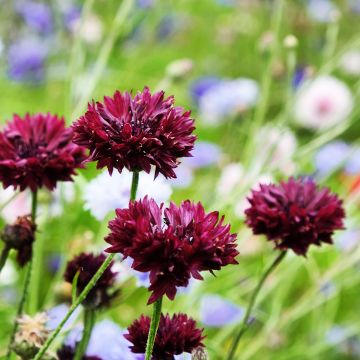

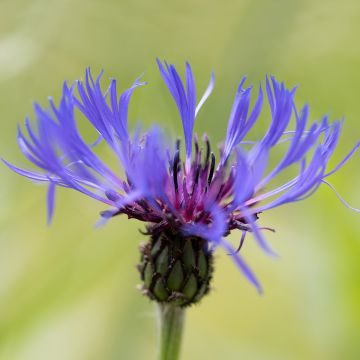

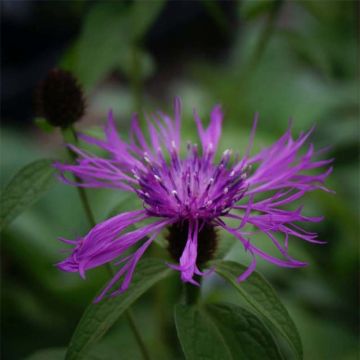
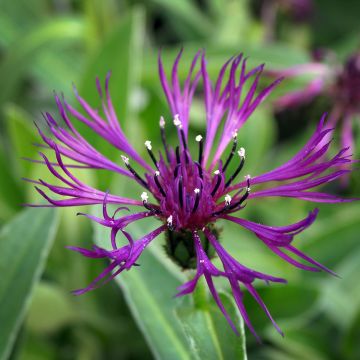
Comments